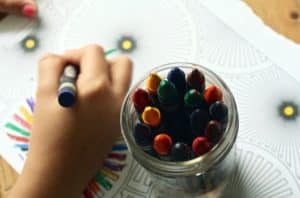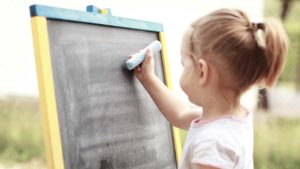 The Slow Death of the Crayon
The Slow Death of the Crayon
How many times have you seen a kid sitting in a restaurant with the parents’ phone in his chubby little hand, and he’s just swiping away with total focus and concentration? I remember when the only thing for kids to do while they waited for their food was to color with three waxy little crayons that went with their place mat.
How many times have you heard a parent say “Little Sally is better at using my iPhone than I am!” Now what happens when you hand the same child a crayon?
Preschoolers are growing up with access to so many wonderful technology tools, but I worry that some parents think that technology is a substitute for more traditional options like a package of crayons and a coloring book. More and more I find that preschool-aged children enter the classroom with little pre-writing experience. Sure, they can rearrange all of the apps on an iPad, but you hand them a crayon and they look at you like you’ve got three heads. Let’s be honest, it’s really easy to hand your child a device. They aren’t going to write on the walls with a device. And parents often think that if their child can do educational games on a phone or tablet, they’re ready for school.
As educators, we need to help parents understand the importance of pre-writing skills in our kiddos. As part of that education, it’s important to understand how children develop writing skills, so here’s a breakdown that parents might find helpful.
It may be easiest for children to learn to write by following this progression:
- Scribble on the page
- Make purposeful marks on the page without going off the page
- Draw basic lines including vertical and horizontal lines, circles with a beginning and ending point, and cross.
- After children can make simple pre-writing strokes, they can begin to put those strokes together to make simple pictures, like a person, house, or flower.
- When first introducing letters, children usually learn the letters in their own name first, because this has meaning to them.
- It is easiest for children to make capital letters first.
- The first letters a child learns are those with vertical and horizontal lines: E, F, H, I, L, and T
- They will then move on to letters with curves: C, G, J, O, Q, and S
- From there, they begin to make letters with big and little curves: B, D, and P
- And finally, they will make letters containing diagonal lines: A, K, M, N, R, W, X, Y, and Z.
So how do we help kids gain the skills they need to be able to write? First and foremost, fine motor practice that helps develop pre-writing skills should be fun! One way to up the fun factor is by incorporating sensory play into the practice. You can give children sensory bags to “draw” on with their fingers, or a tray of rice or flour that they can write in with a paint brush.
 And don’t forget about the importance of having children work on a vertical surface, such as on an easel or whiteboard. Working on a vertical surface helps children coordinate their motor movements, builds core strength, and encourages crossing mid-line. It also give children with emerging skills the chance to make big movements with their arms and hands while they are learning. As they increase their skills, they will be able to refine their movements and work more with their fingers.
And don’t forget about the importance of having children work on a vertical surface, such as on an easel or whiteboard. Working on a vertical surface helps children coordinate their motor movements, builds core strength, and encourages crossing mid-line. It also give children with emerging skills the chance to make big movements with their arms and hands while they are learning. As they increase their skills, they will be able to refine their movements and work more with their fingers.
Children will also benefit from tracing lines, pictures, and letters as they are learning to write. I like to laminate a lot of my printed materials so that children can trace what I’ve filled in using dry erase markers and wipe clean for additional uses. There are several sites that make it simple to print personalized handwriting sheets so that you can individualize practice sheets with your students’ names or other content. Check out Handwritingworksheets.com, AtoZTeacherstuff.com, or worksheetworks.com to get started, and remember that there are fine motor and pre-writing skills in every Read It Once Again unit!
Technology is wonderful, and there are lots and lots of benefits of allowing young children to have access to it, but children also need practice with more traditional tools like markers, pencils, and crayons. So let’s do this, let’s not allow the crayon to die a slow death. Instead, I want you to close your eyes and think back. Think back to a time when you’d open a fresh box of crayons. Imagine all of the potential in those colorful freshly sharpened crayons, and smell the creativity that poured out of the box. I want today’s kids to have that feeling. Don’t you?



